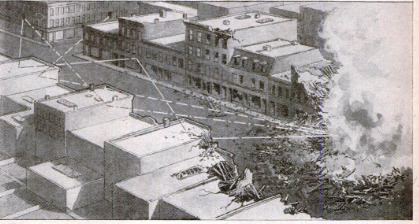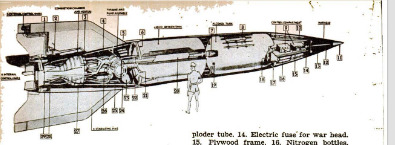-
Title (Dublin Core)
-
What is blast?
-
Article Title and/or Image Caption (Dublin Core)
-
What is blast?
-
extracted text (Extract Text)
-
GERMAN robombs pelting London de-!
molished a house without cracking
the eggs in a dish in the cupboard, blew the
clothes off a woman without ruffling those of |
a man beside her, and killed many persons
without inflicting visible injuries. One vic-
tim, in fact, was found still standing in a
pub with a drink in his hand, but dead. |
These cruel tricks were played by blast.
It is a phenomenon of explosions that oc-
curs so swiftly that it is uncanny, But its]
eerie effects can be explained. Scientists
who have studied blast point out that it can
be both seen and photographed.
Blast is one of three ways in which an
exploding bomb or shell causes destruction.
The other ways are (1) by fragmentation,
or hurling out parts of itself, and (2) by
tossing around chunks of other solid mate-
rial such as paving blocks. The casing
around the explosive in the V-1 and V-2
bombs was too light to cause much damage
by fragmentation. The V-1 bombs did not
penetrate deeply enough when they landed
to dislodge great amounts of other solid
materials. But the blast effects from their
war heads was terrific.
The war heads of the V-2 bombs were
similar, but these bombs penetrated more
deeply than the V-1's. The result, Prime
Minister Churchill has revealed, was “some-
what heavy damage in the immediate vicin-
ity above the crater, with rather less
extensive blast effect around it.”
Blast effect consists of a sudden wave of
pressure, quickly followed by a suction
wave. The pressure wave is caused by the
quick liberation and expansion of immense
quantities of hot gases. The suction wave
results largely from the cooling of these
gases as they encounter resistance and lose
momentum.
The detonation of a high explosive creates
such intense heat that the temperature of
the gases freed is raised several thousand
degrees. These gases burst out in all direc-
tions, much faster than sound travels. Part
of their momentum is transmitted to the,
air, water, earth, or whatever else may sur-
round them. Thus the expanding gases
create an ultra-fierce hurricane which de-
molishes everything in its path until its
force is spent.
The stampede of gases and air leaves a
partial vacuum where the explosion oc-
curred. Air rushes in to fill it, causing a
slower but more prolonged wave of pressure
toward rather than away from the site of
the explosion.
According to an expert on the staff of the
Research and Experiments Department of
the British Ministry of Home Security, the
initial outward pressure from the explosion
of a V-1 robomb caused the most serious
damage, but a greater amount of damage
resulted from the secondary inward pres-
sure. This happened because the first blow
was fierce but short, while the second one
was less intense but lasted longer and could
be felt at a greater distance.
The sudden contact of expanding hot
gases with the atmosphere or other obsta-
cles around them causes a shock wave
which has the same characteristics as a
sound wave—pressure, velocity, amplitude,
and frequency. This shock wave moves
through air, water, or earth like sound,
Both the air blast and the shock wave
start out virtually simultaneously with frag-
ments of the casing or other solid pieces
around the explosive. It takes the heavier,
solid materials longer to gain speed, so the
flying debris lags behind the blast effect at
first. But, once having gained momentum,
the solid pieces hurtling through the air are
harder to slow down and stop, so they may
overtake the hurricane and shock wave.
The turbulence of this extremely swift
rush of forces accounts for many of the
freakish effects. The changes in pressure
may be so great and so rapid around a per-
son as to kill him without leaving an ex-
ternal mark. A woman's clothing, but not a
man's, may be torn off because there is
more air space under a woman's garments
than under a man’s. Blast, like a gust of
wind, can also be deflected by sturdy ob-
stacles.
The British were successful in intercept-
ing a high percentage of the V-1 bombs, but
the V-2's traveled so much higher and faster
that they seemingly struck like lightning,
and the explosion of the first of these re-
taliation weapons was mistaken for the
bursting of a gas main.—VOLTA TORREY.
-
Contributor (Dublin Core)
-
B. G. Seielstad (Article Writer)
-
Language (Dublin Core)
-
eng
-
Date Issued (Dublin Core)
-
1945-01
-
pages (Bibliographic Ontology)
-
90-94
-
Rights (Dublin Core)
-
Public Domain
-
Archived by (Dublin Core)
-
Sami Akbiyik
-
Marco Bortolami (editor)
-
Spatial Coverage (Dublin Core)
-
Germany
 Popular Science Monthly, v. 146, n. 1, 1945
Popular Science Monthly, v. 146, n. 1, 1945
 Ekran Resmi 2022-07-20 13.37.19.png
Ekran Resmi 2022-07-20 13.37.19.png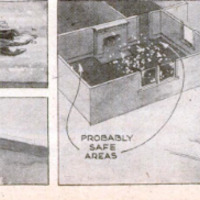 Ekran Resmi 2022-07-20 13.37.24.png
Ekran Resmi 2022-07-20 13.37.24.png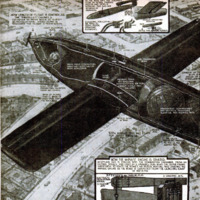 Ekran Resmi 2022-07-20 13.37.34.png
Ekran Resmi 2022-07-20 13.37.34.png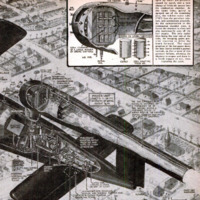 Ekran Resmi 2022-07-20 13.37.43.png
Ekran Resmi 2022-07-20 13.37.43.png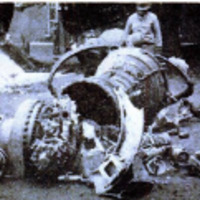 Ekran Resmi 2022-07-20 13.37.53.png
Ekran Resmi 2022-07-20 13.37.53.png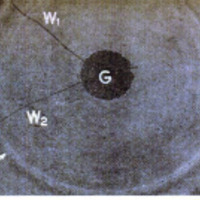 Ekran Resmi 2022-07-20 13.38.04.png
Ekran Resmi 2022-07-20 13.38.04.png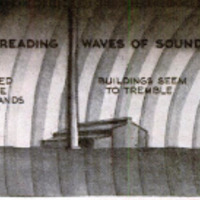 Ekran Resmi 2022-07-20 13.38.10.png
Ekran Resmi 2022-07-20 13.38.10.png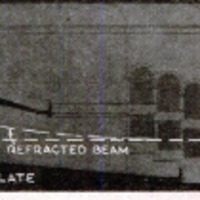 Ekran Resmi 2022-07-20 13.38.15.png
Ekran Resmi 2022-07-20 13.38.15.png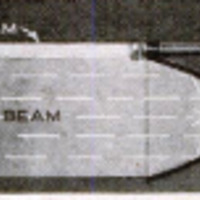 Ekran Resmi 2022-07-20 13.38.21.png
Ekran Resmi 2022-07-20 13.38.21.png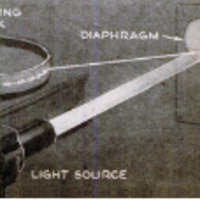 Ekran Resmi 2022-07-20 13.38.25.png
Ekran Resmi 2022-07-20 13.38.25.png Ekran Resmi 2022-07-20 13.38.40.png
Ekran Resmi 2022-07-20 13.38.40.png
